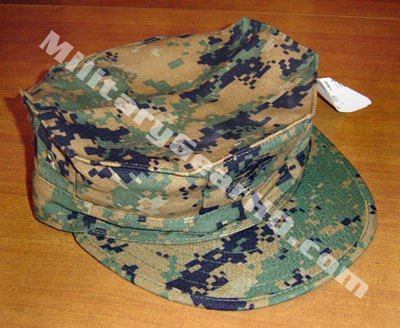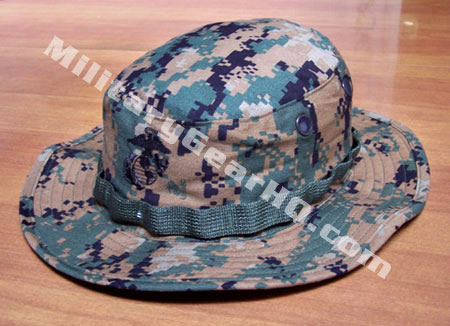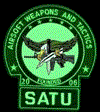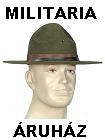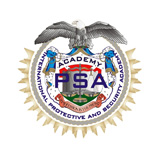-Marine Corps uniforms
Tengerészgyalogság egyenruhái

_
_____________________________________________________________________________
Blue Dress
Officer Blue Dress Uniform. From left to right: “C”,”A”,”A”,”B”,”C”

Enlisted Blue Dress Uniform. From left to right: “B”,”B”,”A”,”D”,”C”

The most recognizable uniform of the Marine Corps is the Blue Dress uniform, often seen in recruiting advertisements. It is often called “Dress Blues” or simply “Blues”. It is equivalent in composition and use to black tie. The various designations are listed in descending order of formality:
* Blue Dress “A” has a long-sleeved midnight blue coat (enlisted members have red trim) with a standing collar and belt (white web belt & gold waistplate for enlisted, midnight blue for officers with a gold M-buckle), white barracks cover (a peaked cap), plain white shirt, sky blue trousers, white gloves, and black shoes and socks. Large medals are worn on the left chest; ribbon-only awards on the right. Marksmanship badges are not worn. Females wear pumps in place of shoes, and may wear a skirt in place of slacks. For males, the dress coat is cut to be formfitting.
* Blue Dress “B” is the same as “A”, but medals are replaced with their corresponding ribbons and all are consolidated on the left. Marksmanship badges may be worn.
* Blue Dress “C” is same as “B” but without the outer blue coat and white gloves. A khaki long sleeve button-up shirt and tie are worn instead. Ribbons and badges are normally worn on the shirt.
* Blue Dress “D” is same as “C”, but with a khaki short sleeve button-up shirt and no tie.
Because the Blue Dress uniform is considered formal wear, Blue Dress “C” and “D” are rarely worn. The main exception are Marine Recruiters and Marine Corps Security Guards, which will wear the “C” and “D” in warm weather. Only the “B”, “C”, and “D” Blue Dress uniforms are authorized for leave and liberty wear; the “A” is not.
General officers have a two-inch wide scarlet “blood stripe” down the outer seam of each leg of their blue dress trousers; field and company grade officers have a 1 1/2-inch wide scarlet stripe down the outer seam of each leg of their blue dress trousers; and Staff NCOs and NCOs have a 1 1/8-inch wide scarlet stripe down the outer seam of each leg of their blue dress trousers. General officers wear trousers that are the same color as the coat, while other officers, Staff NCOs, and NCOs wear medium (sky) blue trousers.
A blue crewneck sweater, in the same color shade as that of the trousers, may be worn with the “C” and “D” uniforms, in which case rank insignia will continue to be worn on the collar by officers and all ranks will wear rank insignia on shoulder epaulets (polished brass for enlisted). The collar is worn on the outside of the sweater in order to display the rated rank insignia of officers. When wearing the crewneck sweater with the long sleeve khaki shirt, a tie is not required.
____________________________________________________________________________
Blue-White Dress
Blue-White and Red Dress Uniforms

Prior to 1998, the “Blue-White” dress uniform was authorized to be worn for the ceremonial units at Marine Barracks, 8th & I in Washington, D.C. (most famously the Silent Drill Platoon and Color guard). Since then, it has become the authorized summer dress uniform for all officers (it replaced, in 2000, an all-white uniform, similar in appearance to that of the Naval Officer/CPO white dress uniform), SNCOs (unless they are in formation with NCOs and junior enlisted personnel who are not authorized to wear the uniform), and by NCOs and junior enlisted personnel for ceremonies and social events only, if authorized and provided by the command structure.
Like the Blue Dress uniform, the Blue-White Dress consists of an “A” and “B” uniform, and is worn in the same manner as that of the Blue Dress uniform, except for the trousers, skirt, or slacks being white instead of blue. Unlike the Dress Blues, the Blue-White Dress uniforms do not feature the “Blood Stripe”. As with the Dress Blues, the “A” is not authorized for leave and liberty wear. The white trousers are not authorized for wear with either the long-sleeved or the short-sleeved khaki shirt, precluding “C” and “D” uniforms.
Red Dress
To differentiate themselves from the infantry, musicians — at that time, merely buglers and signal callers — would reverse the traditional colors. Today’s Marine Corps musicians still carry on such tradition by wearing a scarlet blouse with blue trim instead of the Dress Blues blouse.
Like the Blue-White Dress uniform, musicians are not authorized to wear the khaki shirts with the Red-Dress Uniform. Should the condition warrant (summer heat), the band will wear the appropriate Dress or Service uniforms.
_________________________________________________________________________
Evening Dress
Evening Dress. From left to right: SNCO, “A”, “B”(General officer), “A” with boatcloak,
“B”

The Evening Dress is the most formal (and by U.S. Military standards, the most elaborate) of the Dress uniforms, and is the equivalent of white tie in usage. It is only authorized for wear by officers and SNCO’s, and only a required uniform item for senior officers (Majors and above). It comes in three varieties:
* Evening dress “A” (for officers) is similar to Dress Blue “A”, except an evening coat with strip collar, white waistcoat, and white shirt with pique placket is worn. The stripe on the trousers is a thin red stripe inside a gold stripe instead of scarlet. Females wear a long skirt. Miniature medals and badges are worn.
* Evening dress “B” is identical to Evening Dress “A” except males wear a scarlet waistcoat (General officers) or cummerbund (other officers), and females may wear a short skirt.
* SNCO’s Evening Dress for Staff Non-Commissioned Officers, and much resembles a tuxedo with historic 1890’s-era rank insignia sewn on the sleeves.
A blue boatcloak with a scarlet silk liner is optional. Junior officers not required to possess Evening Dress may substitute Blue or Blue-White dress “A”. It is appropriate for such occasions as State functions, inaugural receptions and dinners, and formal dinners.
_______________________________________________________________________________
Service Uniform
Officer Service Uniform. From left to right:”C”, Service with all-weather coat, “A”, “A”, Service with sweater

Enlisted Service Uniform. From left to right: “C”, Service with sweater, “B”, “A”, “B”

The service uniform consists of olive green and khaki colors. It is roughly equivalent in function and composition to a business suit. It is the prescribed uniform when
* serving on a court-martial
* making official visits and calls on American and foreign dignitaries, officials, and Military officers.
* visiting the White House, except when in a tourist capacity, or on an occasion where another uniform is specified.
* reporting for duty onshore
Like the Blue Dress uniform, the service uniform is authorized for wear while off-duty (on leave or liberty).
The Service uniforms are designated:
* Service “A” (or Alpha) is the base uniform. It consists of a green coat, green trousers with khaki web belt, khaki long-sleeve button-up shirt, khaki tie, tie clasp, and black shoes. The coat is cut to be semi-form fitting, with ribbons and shooting badge worn on the left chest of the coat. Females wear a green necktab in place of the tie, pumps instead of shoes, and have the option of wearing a skirt instead of slacks. It is sometimes appropriate to remove the jacket while indoors.
* Service “B” (or Bravo) is identical to the “A” except the coat is removed. Ribbons may be worn on the shirt.
* Service “C” (or Charlie) is identical to “B” except with a short-sleeve button-up shirt and no tie.
There are three types of authorized headwear for the service uniform. Both males and females may wear the green soft garrison cap, sometimes nicknamed a “piss cutter”. There is the option of wearing a hard-framed service cap (called a Barracks Cover). The design of these covers differ between females and males. As on the Blue Dress uniform, officers wear rank insignia on the shoulder epaulettes of their jackets and the collars of their shirts, while enlisted personnel wear rank insignia sewn on their sleeves.
A green crewneck sweater may be worn with the “B” and “C” uniforms, in which case rank insignia will continue to be worn on the collar by officers and all ranks will wear rank insignia on shoulder eppaulets (black for enlisted). The collar is worn on the outside of the sweater in order to display the rated rank insignia of officers. When wearing the crewneck sweater with the long sleeve khaki shirt, a tie is not required.
_________________________________________________________________________
Utility Uniform
MARPAT Utility Uniform

The Marine Corps Combat Utility Uniform or MCCUU is intended for wear in the field or for working parties, but has become the typical working uniform for all deployed and most garrison Marines and Sailors. It is rendered in MARPAT digital camouflage that breaks up the wearer’s shape, and also serves to distinguish Marine uniforms from those of other services. Previously, Marines wore the same utility uniforms as the Army. It consists of MARPAT blouse and trousers, green undershirt, and tan (specifically “olive mojave”) suede boots. There are two approved varieties of MARPAT, woodland/winter (green/brown/black) and desert/summer (tan/brown/grey). To further distinguish the uniform, upon close examination, the Eagle, Globe, and Anchor can be found within the pattern.
MARPAT woodland variant
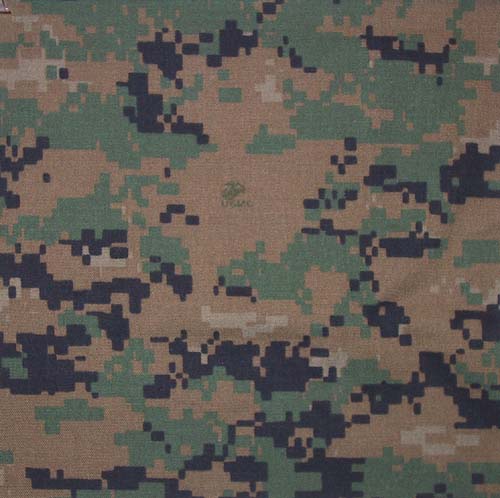
MARPAT desert variant

The variety worn depends on the environment and season: Deployed Marines wear whichever color is more appropriate to the climate and terrain, Marines in garrison wear the woodland MCCUU with long sleeves in winter months, and the desert MCCUU with sleeves rolled up in summer months (the transition occurs simultaneously with Daylight Saving Time). When rolled, the sleeves of the blouse are tightly folded up to the biceps, exposing the lighter inside layer, and forming a neat cuff to present a crisper appearance to the otherwise formless uniform. In the past, when Marines wore the same utilities as the Army and Air Force, this served to distinguish them from the other branches, who folded the sleeves in with the camo facing out. In Haiti, the practice earned them the nickname “whitesleeves”.
Both officers and enlisted wear rank insignia on each collar, which is affixed like a pin and not sewn on as in the Army/Air Force. Enlisted insignia is always black, while officers wear bright metal insignia in garrison and subdued insignia (or none at all) in the field. Most badges and breast insignia are authorized for wear on the Utility uniform, shined or subdued as appropriate. Landing Support Marines also wear the Red Patch insignia.
Unlike the Dress and Service uniforms, utilities are not permitted for wear on leave or liberty (while off-duty), except when traveling in a vehicle a place of duty and a residence, or in emergency stops.
The approved headwear is the utility cover, an eight-pointed brimmed hat that is worn “blocked”, that is, creased and peaked. In the field, a boonie cover is also authorized. The trouser legs are “bloused”, or the cuffs are rolled inside and tightened over their boots with a spring or elastic band known as a “boot band” or “blousing garter”. With the introduction of the Marine Corps Martial Arts Program (MCMAP), Marines now wear color-coded rigger’s belts instead of the old web belt, indicating their level of proficiency in MCMAP (the web belt was phased out in 2008 due to a requirement for all Marines to achieve a tan belt rank by then.
In combat, Marine will also wear one of two ballistic vests: the Outer Tactical Vest and the newer Modular Tactical Vest, as well as the Lightweight Helmet (replacing the PASGT helmet) and Improved Load Bearing Equipment. Marines in a combat area may also wear Flame resistant organizational gear, or FROG uniforms. These combat uniforms are designed to reduce fire-related injuries, and look quite similar to the MCCUU. Other individual equipment may be worn as directed.
The wearing of the MCCUU by civilian contractors deploying with Marine units was granted early in the Iraq War, but rescinded in early 2008.
____________________________________________________________________________
Physical training uniform
New Marine Corps running gear unveiled in December 2007 by CMC General Conway.
The Physical training uniform or PT uniform consists of one of the following pairs:
* green nylon shorts and cotton t-shirt (shirts with unit logos can be authorized)
* green sweatpants and sweatshirt with the Marine Corps emblem printed in black on the left chest and thigh
Commanders will soon be able to authorize a new green tracksuit with gold and scarlet “Marines” lettering and reflective trim as the proper wear. It was unveiled during a tour of Iraq in December 2007, by Commandant of the Marine Corps General James Conway. It will be issued to Marines free of cost, having begun in February 2008 and will be mandatory possession by the end of FY 2009.
In addition, Marines can wear a watch cap and gloves in cold weather, or a hydration pack to prevent dehydration.
The Physical training uniform or PT uniform consists of one of the following pairs:
* green nylon shorts and cotton t-shirt (shirts with unit logos can be authorized)
* green sweatpants and sweatshirt with the Marine Corps emblem printed in black on the left chest and thigh
Commanders will soon be able to authorize a new green tracksuit with gold and scarlet “Marines” lettering and reflective trim as the proper wear. It was unveiled during a tour of Iraq in December 2007, by Commandant of the Marine Corps General James Conway. It will be issued to Marines free of cost, having begun in February 2008 and will be mandatory possession by the end of FY 2009.
In addition, Marines can wear a watch cap and gloves in cold weather, or a hydration pack to prevent dehydration.
https://picasaweb.google.com/usmc.barati.kor/USMCRunningSuit?authuser=0&feat=directlink
_________________________________________________________________________________
Regulations

1. Marines will wear all ribbons to which they are entitled on service and dress “B” coats. Ribbons will be worn on the dress “A” coats only as authorized in paragraph 5202.
2. When the blue dress “C”/”D” or service “B”/”C” uniforms are worn the wearing of ribbons on khaki shirts is at the individual’s option unless the commander prescribes that ribbons be worn. If ribbons are worn on these uniforms, either all ribbons, or personal U.S. decorations with U.S. unit awards and the Good Conduct Medal, may be worn at the individual’s option.
MARINE CORPS UNIFORM REGULATIONS
http://www.marcorsyscom.usmc.mil/sites/mcub/library/MCUR/URTOC.htm
Headwear
- In garrison, a utility cover, also known as an 8-point cover, is worn.
- In the field, the boonie (floppy) cover is worn in non-combat environments.
- The Marine Corps Lightweight Helmet is worn in combat and training with a reversible MARPAT cover
- The Marine Corps Eagle, Globe, and Anchor is embroidered on both the boonie and utility covers. [8]
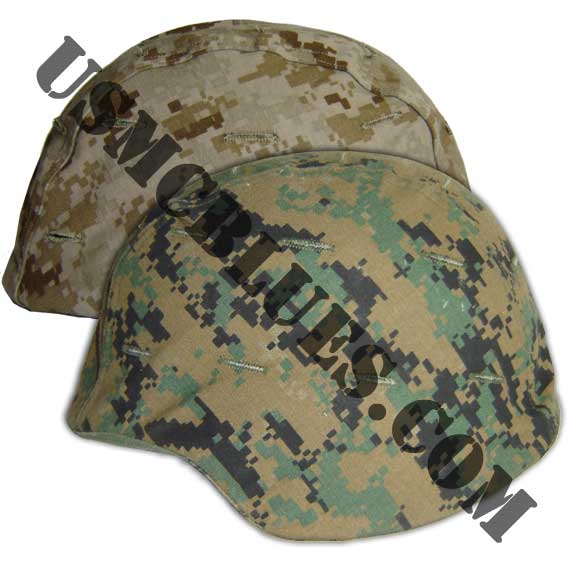
T-Shirt
A olive green tee shirt, or skivvie shirt, without a logo is worn underneath the blouse. [9] Due to the intense heat in Iraq, moisture wicking tee shirts, such as those produced by Under Armour became very popular. However, due to concerns that the shirts would melt to the skin in the event of a fire or explosion, they were banned. [10] However, the Marine Corps has worked with Danskin to develop their own moisture wicking shirts under the “Elite Issue” line, [11] ultimately creating and issuing the Flame Resistant Organizational Gear to troops likely to be exposed to combat.

Boots
The Marine Corps now requires tan rough-out combat boots, either hot weather or temperate weather versions. Commercial versions of this boot are authorized without limitation other than they must be at least 8 inches in height and bear the Eagle, Globe, and Anchor on the outer heel of each boot. Stains and damage to the boot make them unservicable for wear, as well as a heel with excessive wear.

